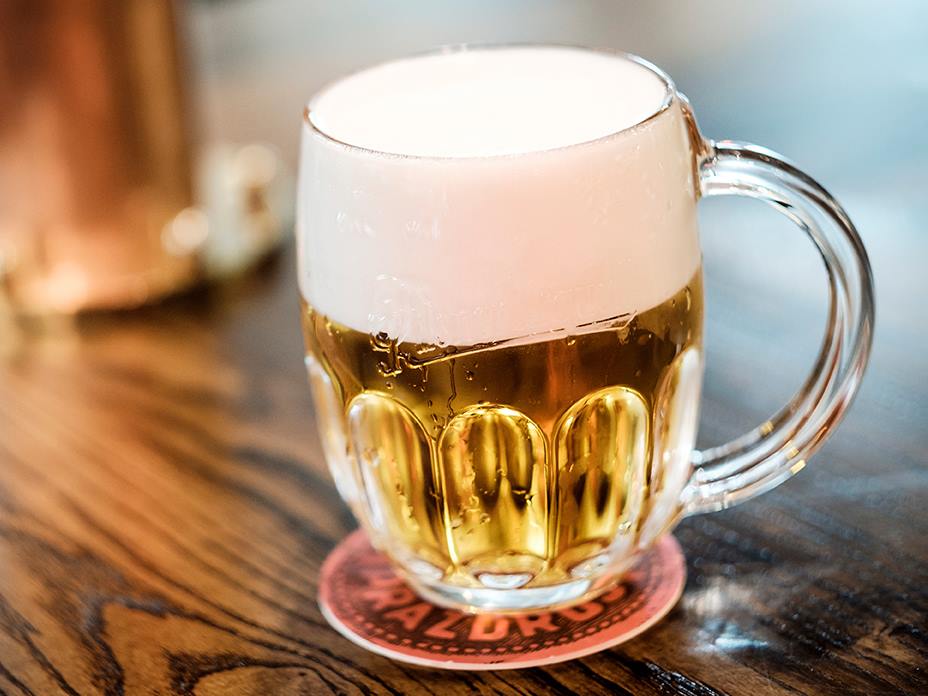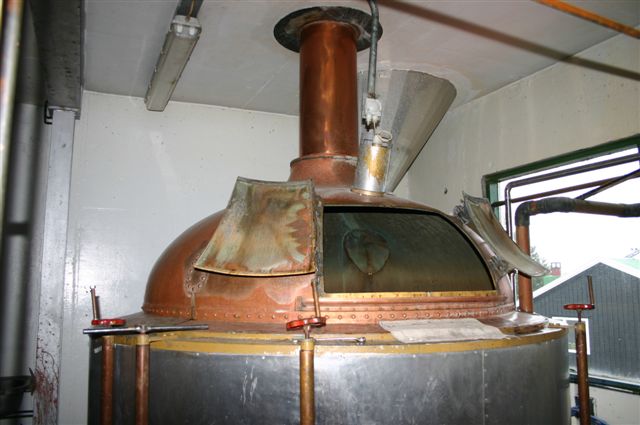|
Föroya Bjór
Föroya Bjór is a Faroese brewing company based in Klaksvík. Apart from beers the company also produces soft drinks. It was established in 1888 in Klaksvík. History In 1883 Símun F. Hansen went to Denmark to learn the art of brewing and baking. Upon his return in the Faroe Islands in 1888, he established his own brewery in Klaksvík, the second to be established in the country. The first brewery was Restorffs Bryggjarí. In 2009 Föroya Bjór opened an office in Reykjanesbær and started exporting its products in Iceland. Name and symbol The name of the brewery means ''The Beer of the Faroes''. The ram is the symbol of Föroya Bjór since its establishment. Product line * Veðrur - 4,6% A pilsner with a combination of malt and hops. * Gold Export Lager - 5,8% A fruity flavour, balanced with a combination of malt and hop flavour. * Jólabryggj - 5,8% * Páskabryggj - 5,8% * Ljóst Pilsnar - 2,7.% * Maltöl - (malt beer) is under 2% abv, and quite malty and sweet. * J� ... [...More Info...] [...Related Items...] OR: [Wikipedia] [Google] [Baidu] |
Klaksvík
Klaksvík () is the second largest town of the Faroe Islands behind Tórshavn. The town is located on Borðoy, which is one of the northernmost islands (the Norðoyar). It is the administrative centre of Klaksvík municipality. History The first settlement at Klaksvík dates back to Viking times, but it was not until the 20th century that the district merged to form a large, modern Faroese town that became a cultural and commercial centre for the Northern Isles and the Faroe Islands as a whole. Klaksvík is located between two inlets lying back to back. It has an important harbour with fishing industry and a modern fishing fleet. Originally, four farms were located where Klaksvík is now. In time, they grew into four villages: Vágur, Myrkjanoyri, Gerðar and Uppsalir; which finally merged to form the town of Klaksvík in 1938. What triggered the development of the town was the establishment of a centralized store for all the northern islands on the location. The brewery Fö ... [...More Info...] [...Related Items...] OR: [Wikipedia] [Google] [Baidu] |
List Of Companies Of The Faroe Islands
The Faroe Islands are an archipelago between the Norwegian Sea and the North Atlantic approximately halfway between Norway and Iceland, north-northwest of mainland Scotland. The islands are an autonomous territory within the Kingdom of Denmark.* * * Economic troubles caused by a collapse of the Faroese fishing industry in the early 1990s brought high unemployment rates of 10 to 15% by the mid-1990s.Statistics Faroe Islands; Labour Market and Wages , accessed 4 August 2009 Unemployment decreased in the later 1990s, down to about 6% at the end of 1998. By June 2008 unemployment had declined to 1.1%, before rising to 3.4% in early 2009. In December 2014 [...More Info...] [...Related Items...] OR: [Wikipedia] [Google] [Baidu] |
Economy Of The Faroe Islands
The economy of the Faroe Islands was the 166th largest in the world in 2014, having a nominal gross domestic product (GDP) of $2.613 billion per annum. GDP increased from DKK 8 billion in 1999, to 21 billion in 2019. The vast majority of Faroese exports, around 90%, consists of fishery products. History After the severe economic troubles of the early 1990s, brought on by a drop in the vital fish catch and poor management of the economy, the Faroe Islands have recently recovered, with unemployment down to 5% in mid-1998, and holding below 3% since 2006, one of the lowest rates in Europe. Challenges and opportunities High dependence on fishing (including salmon farming) means the Faroe Islands' economy remains vulnerable. The Faroese hope to broaden their economic base by building new fish-processing plants. The islands allow up to 25% foreign ownership of ocean industry decreasing gradually until 2032 when foreign ownership must end. Petroleum found close to the Faroese area gi ... [...More Info...] [...Related Items...] OR: [Wikipedia] [Google] [Baidu] |
Dubbel
The term dubbel (also double) is a Belgian Trappist beer naming convention. The origin of the dubbel was a strong version of a brown beer brewed in Westmalle Abbey in 1856, which is known to have been on sale to the public by June 1861. In 1926, the recipe was changed by brewer Henrik Verlinden, and it was sold as ''Dubbel Bruin''. Following World War Two, abbey beers became popular in Belgium and the name "dubbel" was used by several breweries for commercial purposes. Westmalle's Dubbel was imitated by other breweries around the world, both Trappist and secular, leading to the emergence of a style. Dubbels are now understood to be a fairly strong (6–8% alcohol by volume) brown ale, with understated bitterness, fairly heavy body, and a pronounced fruitiness and cereal character. Chimay Première (Red), Koningshoeven/ La Trappe Dubbel, and Achel 8 Bruin are notable examples from Trappist breweries. Affligem and Grimbergen are Belgian abbey breweries that produce dubbels. Not ... [...More Info...] [...Related Items...] OR: [Wikipedia] [Google] [Baidu] |
Hops
Hops are the flowers (also called seed cones or strobiles) of the hop plant ''Humulus lupulus'', a member of the Cannabaceae family of flowering plants. They are used primarily as a bittering, flavouring, and stability agent in beer, to which, in addition to bitterness, they impart floral, fruity, or citrus flavours and aromas. Hops are also used for various purposes in other beverages and herbal medicine. The hops plants have separate female and male plants, and only female plants are used for commercial production. The hop plant is a vigorous climbing herbaceous perennial, usually trained to grow up strings in a field called a hopfield, hop garden (in the South of England), or hop yard (in the West Country and United States) when grown commercially. Many different varieties of hops are grown by farmers around the world, with different types used for particular styles of beer. The first documented use of hops in beer is from the 9th century, though Hildegard of Bingen, 300 y ... [...More Info...] [...Related Items...] OR: [Wikipedia] [Google] [Baidu] |
Malt
Malt is any cereal grain that has been made to germinate by soaking in water and then stopped from germinating further by drying with hot air, a process known as "malting". Malted grain is used to make beer, whisky, malted milk, malt vinegar, confections such as Maltesers and Whoppers, flavored drinks such as Horlicks, Ovaltine, and Milo (drink), Milo, and some baked goods, such as malt loaf, bagels, and Rich Tea biscuits. Malted grain that has been ground into a coarse meal is known as "sweet meal". Malting grain develops the enzymes (α-amylase, β-amylase) required for modifying the grains' starches into various types of sugar, including monosaccharide glucose, disaccharide maltose, trisaccharide maltotriose, and higher sugars called maltodextrines. It also develops other enzymes, such as proteases, that break down the proteins in the grain into forms that can be used by yeast. The point at which the malting process is stopped affects the starch-to-enzyme ratio, and partly ... [...More Info...] [...Related Items...] OR: [Wikipedia] [Google] [Baidu] |
Pilsner
Pilsner (also pilsener or simply pils) is a type of pale lager. It takes its name from the Bohemian city of Plzeň (), where the world's first pale lager (now known as Pilsner Urquell) was produced in 1842 by Pilsner Urquell Brewery. History Origin The city of Plzeň was granted brewing rights in 1307. Until the mid-1840s, most Bohemian beers were top-brewing#Fermenting, fermented. The Pilsner Urquell Brewery, originally called in (, ), is where Pilsen beer was first brewed. Brewers had begun aging beer made with cool fermenting yeasts in caves (lager, i.e., [stored]), which improved the beer's clarity and shelf-life. Part of this research benefited from the knowledge already expounded on in a book (printed in German in 1794, in Czech in 1799) written by Czech brewer () (1753–1805) from Brno. The Plzeň brewery recruited the Bavarian brewer Josef Groll (1813–1887) who, using the local ingredients, produced the first batch of pale lager on 5 October 1842. The combinat ... [...More Info...] [...Related Items...] OR: [Wikipedia] [Google] [Baidu] |
Reykjanesbær
Reykjanesbær () is a municipality on the Southern Peninsula (''Suðurnes'') in Iceland, though the name is also used by locals to refer to the suburban region of Keflavík and Njarðvík which have grown together over the years. The municipality is made up of the towns of Keflavík and Njarðvík and the village of Hafnir. The municipality was created in 1994 when the inhabitants of the three settlements voted to merge them into one. Reykjanesbær is the fourth largest municipality in Iceland, with 21.957 citizens (2024). Overview Of the three towns which make up the municipality, Keflavík is the largest, while Hafnir is the smallest and some 10 kilometers distant. Keflavík and Njarðvík were originally distinct towns but gradually grew together over the course of the latter half of the 20th century, until the only thing separating them was a single street. The northern side of the street belonged to Keflavík and the southern side to Njarðvík. Since May 2009 the township ... [...More Info...] [...Related Items...] OR: [Wikipedia] [Google] [Baidu] |
Faroe Islands
The Faroe Islands ( ) (alt. the Faroes) are an archipelago in the North Atlantic Ocean and an autonomous territory of the Danish Realm, Kingdom of Denmark. Located between Iceland, Norway, and the United Kingdom, the islands have a population of 54,609 and a land area of 1,393 km². The official language is Faroese language, Faroese, which is partially mutually intelligible with Icelandic language, Icelandic. The terrain is rugged, dominated by fjords and cliffs with sparse vegetation and few trees. As a result of its proximity to the Arctic Circle, the islands experience perpetual Twilight, civil twilight during summer nights and very short winter days; nevertheless, they experience a Oceanic climate#Subpolar variety (Cfc, Cwc), subpolar oceanic climate and mild temperatures year-round due to the Gulf Stream. The capital, Tórshavn, receives the fewest recorded hours of sunshine of any city in the world at only 840 per year. Færeyinga saga, Færeyinga Saga and the writin ... [...More Info...] [...Related Items...] OR: [Wikipedia] [Google] [Baidu] |
Restorffs Bryggjarí
Restorffs Bryggjarí was a Faroe Islands, Faroese brewing company established by the Danish-German immigrant Martin Christian Restorff in 1849. History Restorffs Bryggjarí was situated in the capítal Tórshavn, where the majority of its beer production was sold. The brewery was family owned until 2002, when it was sold on to a local businessmen. In 2005 the production of soft drinks (soda drinks) was discontinued letting the other Faroese competitor, Föroya Bjór, take over a few of the brands. In January 2007 the Restorffs Bryggjarí was announced for sale and in August that same year the brewery went out of business. The Föroya Bjór brewery since took over some of the Restorffs beer brands. The brewery only sold its beers in the Faroe Islands though some small quantities were exported to Denmark in the latter years of its existence. Restorffs was one of the oldest brewing companies in the Danish Kingdom. References External links * * * {{DEFAULTSORT:Restorffs ... [...More Info...] [...Related Items...] OR: [Wikipedia] [Google] [Baidu] |




